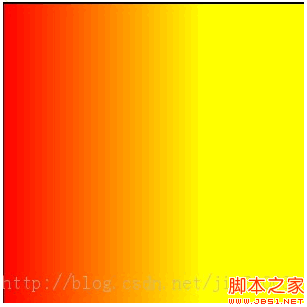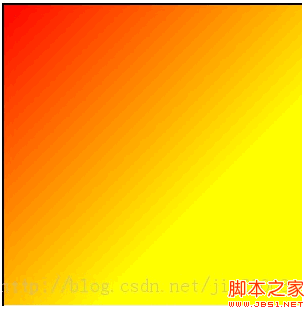 Web Front-end
Web Front-end
 H5 Tutorial
H5 Tutorial
 HTML5 Canvas progressive filling and transparency realize image Mask effect
HTML5 Canvas progressive filling and transparency realize image Mask effect
HTML5 Canvas progressive filling and transparency realize image Mask effect
This article will give you a detailed introduction to the setting and use of transparency in Canvas, combining progressive filling and transparency support to achieve the Mask effect of the image. The code demonstration of the linear progressive method is as follows. Interested friends can refer to it. I hope it will be helpful to you. Everyone is helpful
Explain in detail the parameter settings and use of progressive filling in HTML5 Canvas, the setting and use of transparency in Canvas, and combine the progressive filling and transparency support to achieve the Mask effect of the image.
1: Gradient Fill
Canvas supports two gradual filling methods, one is Linear Gradient Fill (Line Gradient Fill), and the other is called
It is RadialGradient Fill. The APIs are:
createLinearGradient(x1, y1, x2, y2);
where x1, y1 are the coordinates of the first point, and x2, y2 are the coordinates of the second point.
createRadialGradient(x1, y1, r1, x2, y2, r2);
where x1, y1 are the coordinates of the first center point, r1 is the radius, x2, y2 are the coordinates of the second center point, and r2 is radius.
Set the color for each point
addColorStop(position, color);
position represents the position, the size range is [0~1], 0 represents the first point, and 1 represents the coordinates of the second point
Color represents the color value, any CSS color value.
After the progressive fill object is created and configured, it can be used to set the strokeStyle and fillStyle of the context to implement text,
Gradual color filling of geometric shapes.
Code demonstration of linear gradient method:
1. Vertical (Y) direction color gradient
// vertical/Y direction var lineGradient = ctx.createLinearGradient (50, 0, 50, 200); lineGradient.addColorStop(0, 'rgba(255, 0, 0, 1)'); lineGradient.addColorStop(1, 'rgba(255, 255, 0, 1)'); ctx.fillStyle = lineGradient; ctx.fillRect(0, 0, 300, 300);

2. Horizontal (X) direction color gradient
// horizontal/X direction var lineGradient = ctx.createLinearGradient (0, 50, 200, 50); lineGradient.addColorStop(0, 'rgba(255, 0, 0, 1)'); lineGradient.addColorStop(1, 'rgba(255, 255, 0, 1)'); ctx.fillStyle = lineGradient; ctx.fillRect(0, 0, 300, 300);

3. Vertical and horizontal color gradient at the same time (XY direction)
// vertical and horizontal direction var lineGradient = ctx.createLinearGradient (0, 0, 200, 200); lineGradient.addColorStop(0, 'rgba(255, 0, 0, 1)'); lineGradient.addColorStop(1, 'rgba(255, 255, 0, 1)'); ctx.fillStyle = lineGradient; ctx.fillRect(0, 0, 300, 300);

2: Transparency (Transparent)
Transparency support in Canvas is divided into global and local transparency settings. Global transparency settings can be set by setting
Context .globalAlpha is implemented. Local transparency can be achieved by setting the alpha value channel
in the color value through fillStyle. The codes for the two methods are as follows:
// change global alpha value ctx.globalAlpha=0.5; ctx.fillRect(50,50,75,50);
// change fill style color's alphachannel ctx.fillStyle = 'rgba(225,225,225,0.5)'; ctx.fillRect(50,50,75,50);
The two effects are the same.
3: Photo Transparent Gradient Mask Effect
Use radial color gradients and transparency changes to achieve a translucent mask effect on the image, script running effect: 
var myImage = document.createElement('img');
myImage.src = "../test.png";
myImage.onload = function() {
ctx.drawImage(myImage, 80, 30, myImage.naturalWidth, myImage.naturalHeight);
var radialGradient = ctx.createRadialGradient (canvas.width/2, canvas.height/2, 10, canvas.width/2, canvas.height/2, 200);
radialGradient.addColorStop(0, 'rgba(247, 247, 247, 0)');
radialGradient.addColorStop(0.7, 'rgba(120, 120, 120, 0.5)');
radialGradient.addColorStop(0.9, 'rgba(0, 0, 0, 0.8)');
radialGradient.addColorStop(1, 'rgba(238, 238, 238, 1)');
ctx.beginPath();
ctx.arc(canvas.width/2, canvas.height/2, 300, 0, Math.PI * 2, true);
ctx.closePath();
ctx.fillStyle = radialGradient;
ctx.fill();
}The above is the entire content of this article. I hope it will be helpful to everyone’s study. For more related content, please pay attention to the PHP Chinese website!
The above is the detailed content of HTML5 Canvas progressive filling and transparency realize image Mask effect. For more information, please follow other related articles on the PHP Chinese website!

Hot AI Tools

Undresser.AI Undress
AI-powered app for creating realistic nude photos

AI Clothes Remover
Online AI tool for removing clothes from photos.

Undress AI Tool
Undress images for free

Clothoff.io
AI clothes remover

Video Face Swap
Swap faces in any video effortlessly with our completely free AI face swap tool!

Hot Article

Hot Tools

Notepad++7.3.1
Easy-to-use and free code editor

SublimeText3 Chinese version
Chinese version, very easy to use

Zend Studio 13.0.1
Powerful PHP integrated development environment

Dreamweaver CS6
Visual web development tools

SublimeText3 Mac version
God-level code editing software (SublimeText3)

Hot Topics
 1653
1653
 14
14
 1413
1413
 52
52
 1305
1305
 25
25
 1251
1251
 29
29
 1224
1224
 24
24
 Which schools use canvas?
Aug 18, 2023 pm 05:59 PM
Which schools use canvas?
Aug 18, 2023 pm 05:59 PM
Schools using canvas include Stanford University, MIT, Columbia University, University of California, Berkeley, etc. Detailed introduction: 1. Stanford University uses Canvas as its main online learning platform. Teachers and students at Stanford University use Canvas to manage and communicate course content, and learn through functions such as online discussions, assignment submissions, and exams; 2. Ma Provincial Polytechnic Institute and MIT also use Canvas as their online learning management system and conduct course management through the Canvas platform; 3. Columbia University, etc.
 Learn the canvas framework and explain the commonly used canvas framework in detail
Jan 17, 2024 am 11:03 AM
Learn the canvas framework and explain the commonly used canvas framework in detail
Jan 17, 2024 am 11:03 AM
Explore the Canvas framework: To understand what are the commonly used Canvas frameworks, specific code examples are required. Introduction: Canvas is a drawing API provided in HTML5, through which we can achieve rich graphics and animation effects. In order to improve the efficiency and convenience of drawing, many developers have developed different Canvas frameworks. This article will introduce some commonly used Canvas frameworks and provide specific code examples to help readers gain a deeper understanding of how to use these frameworks. 1. EaselJS framework Ea
 What are the canvas arrow plug-ins?
Aug 21, 2023 pm 02:14 PM
What are the canvas arrow plug-ins?
Aug 21, 2023 pm 02:14 PM
The canvas arrow plug-ins include: 1. Fabric.js, which has a simple and easy-to-use API and can create custom arrow effects; 2. Konva.js, which provides the function of drawing arrows and can create various arrow styles; 3. Pixi.js , which provides rich graphics processing functions and can achieve various arrow effects; 4. Two.js, which can easily create and control arrow styles and animations; 5. Arrow.js, which can create various arrow effects; 6. Rough .js, you can create hand-drawn arrows, etc.
 What versions of html2canvas are there?
Aug 22, 2023 pm 05:58 PM
What versions of html2canvas are there?
Aug 22, 2023 pm 05:58 PM
The versions of html2canvas include html2canvas v0.x, html2canvas v1.x, etc. Detailed introduction: 1. html2canvas v0.x, which is an early version of html2canvas. The latest stable version is v0.5.0-alpha1. It is a mature version that has been widely used and verified in many projects; 2. html2canvas v1.x, this is a new version of html2canvas.
 What are the details of the canvas clock?
Aug 21, 2023 pm 05:07 PM
What are the details of the canvas clock?
Aug 21, 2023 pm 05:07 PM
The details of the canvas clock include clock appearance, tick marks, digital clock, hour, minute and second hands, center point, animation effects, other styles, etc. Detailed introduction: 1. Clock appearance, you can use Canvas to draw a circular dial as the appearance of the clock, and you can set the size, color, border and other styles of the dial; 2. Scale lines, draw scale lines on the dial to represent hours or minutes. Position; 3. Digital clock, you can draw a digital clock on the dial to indicate the current hour and minute; 4. Hour hand, minute hand, second hand, etc.
 uniapp implements how to use canvas to draw charts and animation effects
Oct 18, 2023 am 10:42 AM
uniapp implements how to use canvas to draw charts and animation effects
Oct 18, 2023 am 10:42 AM
How to use canvas to draw charts and animation effects in uniapp requires specific code examples 1. Introduction With the popularity of mobile devices, more and more applications need to display various charts and animation effects on the mobile terminal. As a cross-platform development framework based on Vue.js, uniapp provides the ability to use canvas to draw charts and animation effects. This article will introduce how uniapp uses canvas to achieve chart and animation effects, and give specific code examples. 2. canvas
 What properties does tkinter canvas have?
Aug 21, 2023 pm 05:46 PM
What properties does tkinter canvas have?
Aug 21, 2023 pm 05:46 PM
The tkinter canvas attributes include bg, bd, relief, width, height, cursor, highlightbackground, highlightcolor, highlightthickness, insertbackground, insertwidth, selectbackground, selectforeground, xscrollcommand attributes, etc. Detailed introduction
 Explore the powerful role and application of canvas in game development
Jan 17, 2024 am 11:00 AM
Explore the powerful role and application of canvas in game development
Jan 17, 2024 am 11:00 AM
Understand the power and application of canvas in game development Overview: With the rapid development of Internet technology, web games are becoming more and more popular among players. As an important part of web game development, canvas technology has gradually emerged in game development, showing its powerful power and application. This article will introduce the potential of canvas in game development and demonstrate its application through specific code examples. 1. Introduction to canvas technology Canvas is a new element in HTML5, which allows us to use



